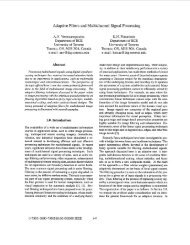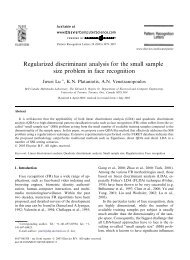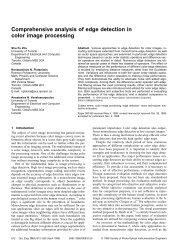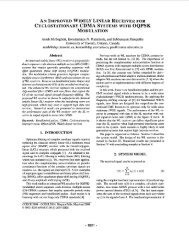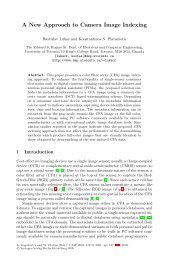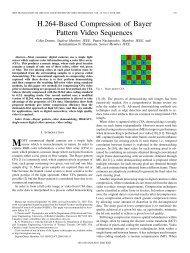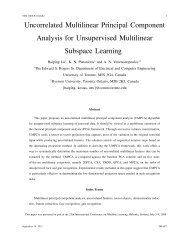Color Filter Arrays: Design and Performance Analysis - Multimedia ...
Color Filter Arrays: Design and Performance Analysis - Multimedia ...
Color Filter Arrays: Design and Performance Analysis - Multimedia ...
Create successful ePaper yourself
Turn your PDF publications into a flip-book with our unique Google optimized e-Paper software.
1262IEEE Transactions on Consumer Electronics, Vol. 51, No. 4, NOVEMBER 2005BlackMagentaRedYellow(a)zdimageinterpolationdemosaicking stepxWhite(b)BlueCyanGreenESMSMESMSMFig. 3. Additive color mixing concept. Any spectrally shifted color canbe obtained using the different amount of the three RGB primary colors.zdimageinterpolationdemosaicking stepimageinterpolationpostprocessing stepx(Figs. 2a-c,g,i,j). Since the frequency of the G color b<strong>and</strong> is closeto the peak of the human luminance frequency response [17],[18],privileging the G color filters in the CFA layout improves theperceived sharpness of the captured image.Image sensor imperfections are usually observed along rows orcolumns of the sensor cells <strong>and</strong> thus, the CFAs shown in Figs. 2e,fshould avoid the visual impairments resulting from the sensordefects. Immunity to optical/electrical cross talk betweenneighboring pixels can be increased by creating the CFA with thefixed number of neighbors corresponding to each of the threeprimary colors. This request is even more important due to the factthat diagonally located neighbors have a lower cross-talkcontribution than the vertically or horizontally located neighbors[12], making the CFAs shown in Figs. 2g-j the worst solutions interms of this criterion.Since no CFA satisfies all design conditions, manufacturersusually select the CFA layout according to the type <strong>and</strong> resolutionof the image sensor, camera optical system, image processingcapabilities of the device, <strong>and</strong> the intended application. However,once the CFA layout is selected to acquire the CFA image data, thevisual quality of the demosaicked full-color image depends on theability of the demosaicking solution to overcome various spatial,structural <strong>and</strong> spectral constraints imposed on the single-sensordevice during the image formation <strong>and</strong> color reconstruction.B. Universal Demosaicking FrameworkThe acquired CFA image is a K1× K2gray-scale mosaic-like2image z : Z → Z with the single scalar value z ( rs , )located ateach spatial location (,). rs Operating along the row <strong>and</strong> columncoordinates r = 1, 2,..., K1<strong>and</strong> s = 1,2,..., K2, respectively, theinformation about the R ( k = 1) , G ( k = 2) , or B ( k = 3) colorfilters in the CFA can be stored using the location flags d ( rsk , )obtained either from the CFA layout or using the TIFF-EP storageformat [14]. Following the dimensions of the CFA image z , a2 3K1× K2vectorial field d : Z → Z of the correspondinglocation flags d( rsk , )is initialized using the default value d( rsk , )= 1to indicate the presence of the k -th color filter at the sensorlocation (,), rs <strong>and</strong> using the flags set to d ( rsk , )= 0 in all othercases.Fig. 4. Two basic solutions designed within the universaldemosaicking framework [14]: (a) non-adaptive component-wisesolution, (b) edge-sensing spectral model based solution with thepostprocessor.The CFA image z is used as the input to a demosaickingsolution which performs spectral interpolation [9] to obtain a2 3K1× K2demosaicked full-color image x : Z → Z . Thedemosaicking process starts by re-arranging the CFA image(Fig. 1a) to its color variant (Fig. 1b). Using the location flagsd( rsk , ), the scalar CFA image data z ( rs , )are transformed to thecorresponding vectorial representation x (,) rs= [ x (,) rsk, x (,) rsk, x (,) rsk]withx( rsk , )denoting the intensity in the R ( k = 1) , G ( k = 2) , or B( k = 3) channel of the color image x . Thus, the process producesthe color vector x ( rs , )= [ z ( rs , ),0,0] for d ( rs , )1= 1, x( rs , )= [0, z( rs , ),0]for d( rs , )2= 1, <strong>and</strong> x ( rs , )= [0,0, z ( rs , )] for d ( rs , )3= 1. Given thelocation flags d ( rsk , )= 0 denoting the missing components inx( rs , ), the corresponding values of x ( rsk , )are set equal to zero todenote their portion to the coloration of the color image x shownin Fig. 1b.To produce a full-color image (Fig. 1c), the missingcomponents are estimated at each spatial location (,) rs from theavailable neighboring components using the concept of imageinterpolation [9]. Using a 3× 3 sliding window instead of thespecialized shape masks known from the Bayer CFA-baseddemosaicking solutions (e.g. [1],[4],[6]-[8],[15]-[22]), theuniversal demosaicking framework [14] is directly applicable to anarbitrary CFA shown in Fig. 2. By localizing the flags d ( rsk , )= 0used to indicate the spatial location (,) rs in the k -th colorchannel to be demosaicked <strong>and</strong> utilizing the control mechanism toprevent from operating in areas which lack adequate inputinformation, the framework obtains the essential flexibility <strong>and</strong>independence from the CFA layout. In addition, the frameworkoffers a number of design <strong>and</strong> processing options to demosaick theacquired CFA data, ranging from the cost-effective non-adaptivecomponent-wise solutions (Fig. 4a) to sophisticated solutions(Fig. 4b) which use the edge-sensing mechanism (ESM), thespectral model (SM) <strong>and</strong> the postprocessor to produce thedemosaicked image pleasing for viewing. The interested readercan find the detailed description of the universal demosaickingframework <strong>and</strong> the two considered here solutions (Fig. 4) in [14].



